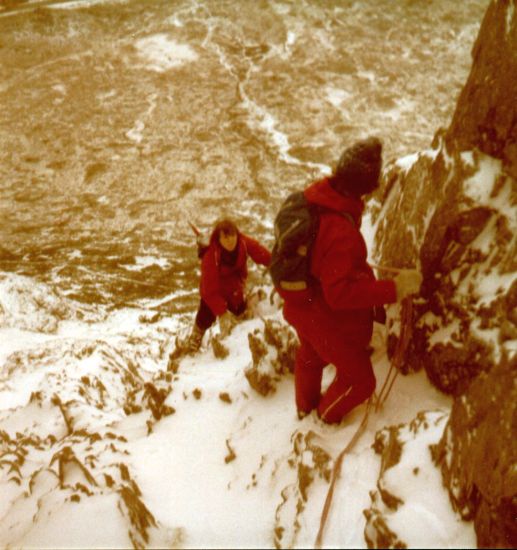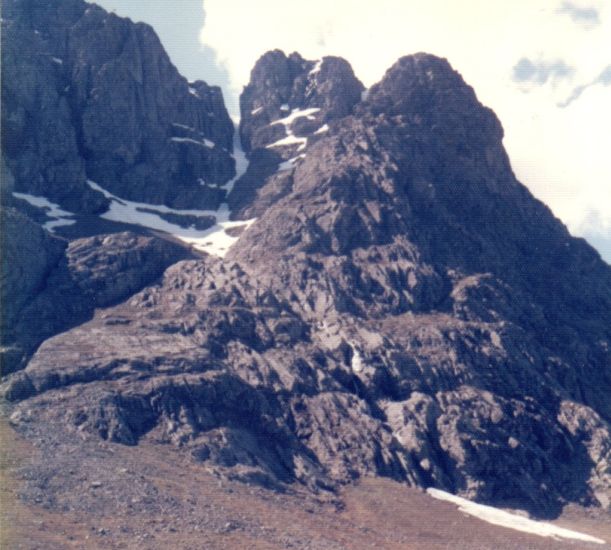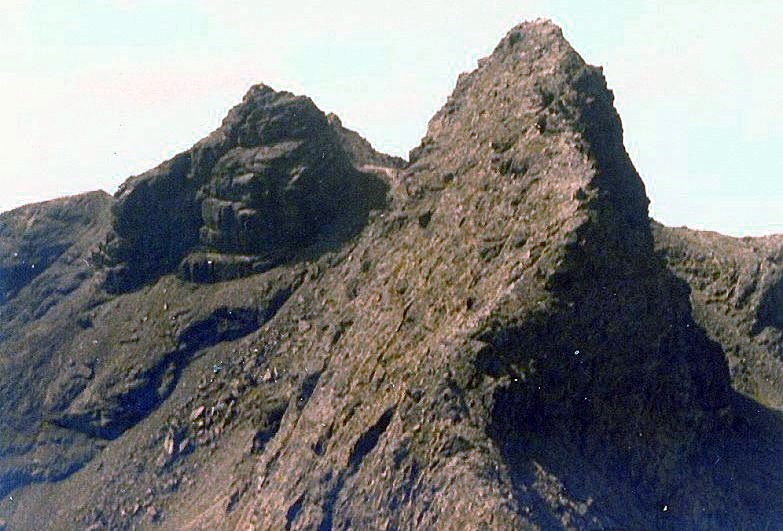

While many will be content to confine their activities to certain branches of the sport the complete mountaineer requires skills and experience ranging from basic hiking through hill-walking and ski-ing to rock, snow and ice-climbing.
As in all fields of endeavour experts make their talents appear deceptively simple and easy to emulate. From safe stances with both feet firmly on solid ground I have watched in amazement and apprehension as extreme rock-climbers have performed their death and gravity defying feats on adjacent, seemingly-sheer, perpendicular faces. However if something is worth doing it is worth doing badly and even a moderate ability in rock-climbing skills and techniques can prove invaluable to a mountaineer not only in enabling ascents of otherwise inaccessible summits but also in getting back down.
Scottish peaks such as Ben Nevis and Buachaille Etive Mor are Jekyll and Hyde mountains presenting on one side an easy angled approach eminently suitable for hill-walkers but another completely different, more fearsome and challenging aspect providing interesting diversions for rock aficionados.
Contrary to initial impressions gained on the approach across Rannoch Moor ( many have shaken their heads in disbelief ), Curved Ridge, winding its way up the precipitous east face to the very top of the Buachaille, is an excellent and highly-enjoyable, introductory route for beginners giving great satisfaction and sense of accomplishment. ( It is of course an entirely different proposition and a much more serious undertaking under winter conditions ).

Curved Ridge on Buachaille Etive Mor in winter |
On the far side of its 'Tourist Route', Ben Nevis provides three fine ridges sweeping up from the Allt na Mhuilinn to culminate on its rocky plateau. The first of these, Castle Ridge, is only a grade above Curved Ridge while higher up the glen the gigantic Douglas Boulder marks the start of the somewhat longer and still harder Tower Ridge. The short but deep gap in its narrow upper arete is the crux of the route.

Castle Ridge on Ben Nevis |
Nearing the head of the glen is Observatory Ridge - a classic climb leading directly to the summit and the most difficult of the three ridges. Negotiating its "Bad Step" stretched my rock-climbing abilities to their limit - a very tight rope was a big help - it presented a greater problem than any encountered on the normal route of the Eiger. However, routes that require taking hands out of pockets are a good antidote to feelings of fatigue and certainly enliven otherwise straightforward footslogging.
The three ridges are at there most impressive if viewed from the Carn Mor Dearg arete directly opposite when they appear completely vertical and utterly impossible.
Of all the 284 Munros the only one where a graded rock climb is unavoidable is the Inaccessible Pinnacle of Sgurr Dearg on the Island of Skye. The exposed, airy scramble along the crumbling, eastern crest of the slender fin is best done in heavy mist when the sheer drops on either side are not so manifest and less frightening. It is also the only Munro where an abseil is the ideal way to escape from the summit - down-climbing would be worse than the ascent.

Am Bhasteir from Sgurr nan Gillean on the Skye Ridge |
Abseiling ( or rapelling to use the continental term ) is an essential mountaineering technique and practice gained on the rock outcrops of the Whangie on Dunbarton Moor proved useful in retreating down the Hornli Ridge of the Matterhorn where ring pitons have been placed for this very purpose. Crossing the Mingbo La high pass in the Everest region of the Nepal Himalaya to escape the confines of the isolated Hongu Valley two, double-length ( ie 60 metre ) ropes were required to abseil down the 70 degree ice-flutings and over the bergschrund to gain the level surface of the Nare Glacier. Further abseils were needed at the snout of the glacier.

Mingbo La |
In extreme circumstances, using the classic technique to abseil, only a climbing rope is necessary but a tape sling used as a seat harness together with a karabiner makes life much more comfortable. For descents from major summits involving repeated abseils a figure-of-eight descendeur may be worth its additional weight. Although abseiling allows rapid descents carelessness - failure to hold on to both ends of a rope doubled through a belay or not tying a security knot at the end of an abseil rope - has resulted in many accidents and fatalities. Jamming can also be a problem - on Mont Blanc we had to assist a pair of French climbers retrieve their rope stuck in a belay.
An introductory course on basic rock-climbing equipment and techniques from a competent practioner in conjunction with one of the many good guide books available opens many new avenues of exploration not only in the Scottish Highlands but also further afield in the European Alps and the Himalaya. On trek my slings have been used by Sherpas as a substitute for broken namros ( head straps for load carrying ) while in many circumstances an ability to tie a proper knot such as a bowline can be a handy attribute.
( The Commentator, The (Glasgow) HERALD, Monday 22nd December 1999 )
Glencoe | Ben Nevis | Knoydart | Isle of Skye | Isle of Arran
The Eastern Highlands | The Central Highlands | The Southern Highlands
The NW Highlands | The West Highland Way